Cappadocia Underground Cities
Introduction
Cappadocia Underground Cities -Turkey’s Cappadocia region is famous for its subterranean safe cities carved from soft tuff. These underground cities, which are among the most interesting cultural richness of Cappadocia, take tourists from all over the world on a mysterious journey every year. The underground cities in Cappadocia, interconnected by corridors, were used as hiding places by Christians in the 7th century. These subterranean cities were self sufficient cities with granaries, stables, rooms, kitchens and ventilation systems. The most famous underground cities uncovered until now around Cappadocia are found in Derinkuyu, Kaymakli, Tatlarin, Ozkonak, Mazi and Ozluce. Derinkuyu Underground City and Kaymakli Underground Cities were inscribed on the UNESCO World Heritage List in 1985. Today, visiting these magnificent structures is one of the most splendid and attractive part of Cappadocia tours.
Discover your perfect Turkey vacation package using our convenient search and filter options, tailor-making a journey that captures Turkey’s unique beauty and rich heritage just for you.
Short History
It is believed that the Cappadocia underground cities were initially built by the Phrygians during the 8th through 7th centuries BCE, who carved their living spaces into the region’s soft volcanic rock. Later on, during the Roman era and the replacement of the Phrygian language with Greek, the then Christian inhabitants continued to work on the underground cities adding their own cultural and religious necessities such as chapels and Greek inscriptions. Underground cities like Derinkuyu continued to protect their citizens as far as the 14th century when Christians once again needed a safe haven from the threat of the Mongolians during the assaults on Timur, and once again during the Ottoman era, when protection was needed from the Turkish Muslim powers. Even during the 20th century, the caves allowed for people to save themselves from persecution administered during the Ottoman Empire. It was not until 1923, after the population exchange between Greece and Turkey, that the underground cities were completely abandoned and then not rediscovered until 1963. The story goes that a resident found a strange room behind a wall inside his house, and the rest is history!
What is an Underground City?
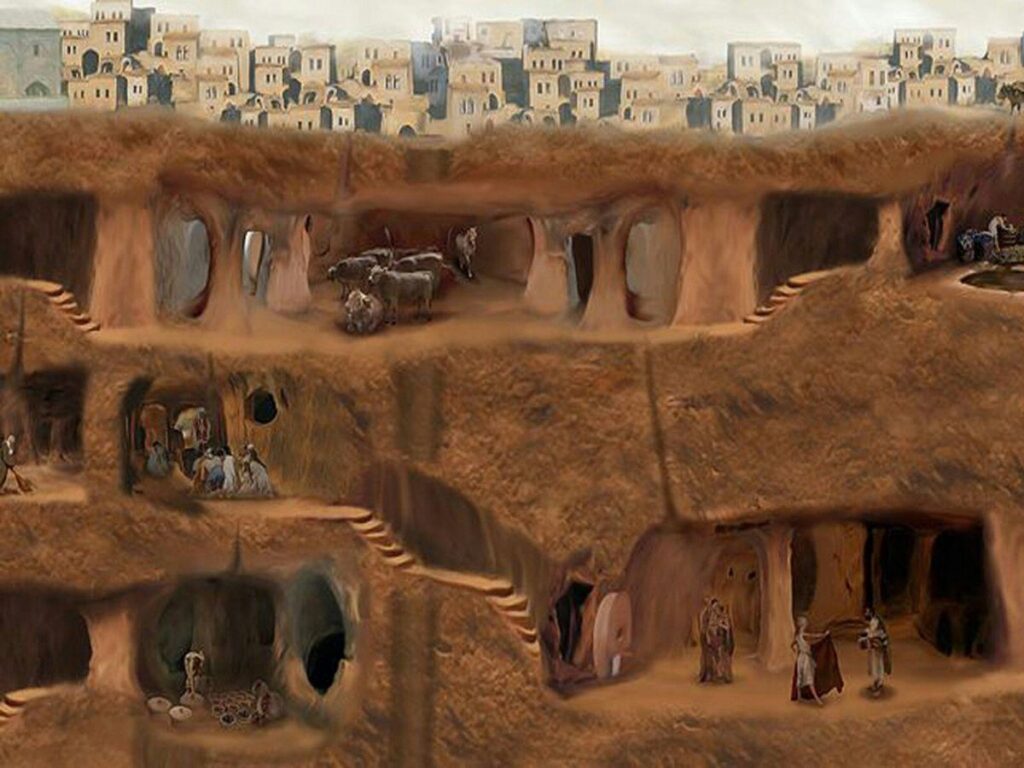
Underground city is a system of caves located in the underground, obviously. Hittite communities started to expand to South of Anatolia. These wine making farmers used to dig caves into the ground before. Thanks to the iron tools, now they were able to carve the soft volcanic rock faster than before. They started to take advantage from the nature of these volcanic rocks and kept their wine. The volcanic rocks are constantly absorbing the humidity and the heat which creates a stable temperature. There is not a dramatic change in the temperatures despite the weather conditions outside. As a result, underground caves are very convenient for wine making and wine cellar uses. Increasing population required more caves in the underground. Along with Hittites, all the communities who reigned in Cappadocia added caves, ventilation shafts, water reservoirs, storages, tunnels, shelters and wineries to the underground. Starting from the 12th Century BC, people of Cappadocia carved caves into the underground until the 12th Century AD. For more than two thousand years, more than a hundred underground cities were carved in Cappadocia. During history, function of the caves have changed as well as their size and depth. First, Hittites used them for wine making, food storage and animal shelters. When they were disturbed by their middle eastern or east European enemies, Hittite communities started to enlarge the caves into the underground and used them for defensive purposes. Growing population required more shelters so the underground cities were enlarged by the other civilizations once ruled Cappadocia. Phrygians and Romans used them for same reason like Hittites. But the biggest contributors to the architecture of the underground cities are Greek, Roman and Anatolian people who accepted Christianity before the Roman Empire. To protect form the Christian Persecution, underground cities reached to their present day sizes. The main purpose of the underground cities have changed after Turks arrived to Cappadocia. Underground cities did not expand after the thirteenth century because of lack of wars. People continued to use the superficial caves for the very same reasons as Hittites but the deeper caves were forgotten because no one needed to shelter from an enemy. Upcoming generations forgot the underground caves deeper levels. After the population exchange in between Greeks and Turks, Underground cities importance were forgotten. But in 1960s, two underground cities were converted to museums by the Ministry of Tourism and Culture. Since 1985, Derinkuyu Underground city is a UNESCO Heritage Site.
This is the list of 6 subterranean cities in Cappadocia dating back to 3000 BC.
Ozkonak Underground City (Map)
Ozkonak is a small town located in the north of the popular Cappadocia cities like Uchisar, Goreme and Avanos. It is just ten miles away from Avanos town. The location of the underground city is so convenient that in one hour, you can reach to the underground city from Kayseri Erkilet Airport. Moreover, Ozkonak Underground City is just thirty minutes away from Nevsehir Kapadokya Airport. A comprehensive tour in the underground city is a comprehensive tour of Cappadocia. Even if the underground cities are caves dug into the ground like an ant house, the history of the structure is giving you plenty of information about the history of Cappadocia.
Derinkuyu Underground City (Map)
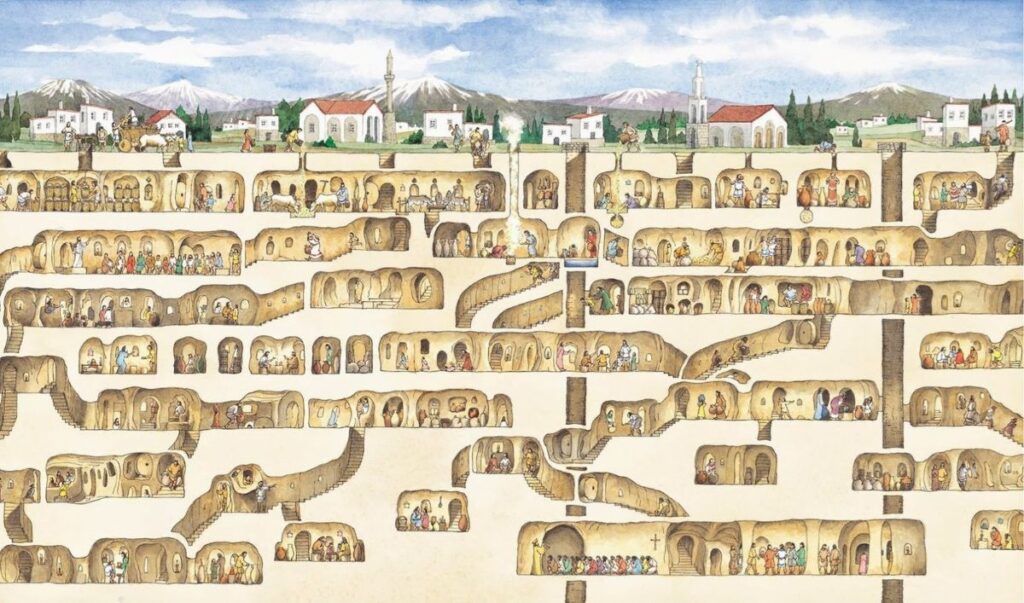
Derinkuyu Underground City reached to present day condition during the Roman Ages. The underground city is named after the town which was called Malakopea in Greek. The huge ventilation shaft of the underground city was also a water well to the people living on the surface. New Turkish settlers of Malakopea named after their new home after the well and called it Derinkuyu meaning deep well. This is a very nice coincidence as the underground city of Derinkuyu is the deepest cave dwelling in Cappadocia region. The caves were rediscovered by a curious villager. He started to wonder what was behind the walls in his caves underneath his house. After deconstructing them, he found more caves reaching deeper. A few years later, the dwellings were converted to a museum. The city has more than eight levels, wineries, linseed oil factories, shelters, storages, kitchens, ventilation shafts, grave yards, water reservoirs, waterwells, stalls, churches and most importantly a theological school. The most impressive artefacts of the underground cities are stone wheel doors which will take you to an Indiana Jones movie stage. The numerous stone doors are showing the numerous attacks these people had to shelter from. The circular stairs taking you deeper after entering to the stall of the underground city is like exploring a chateau in Middle Ages. After reaching to storage area, you are able to use the one way tunnel to reach to the bottom of the underground city. The church, grave yard, water well and the bottom of the ventilation shaft can be seen in the deepest level of the underground city. On the way back to the sunlight, you are able to see more storages, wineries and the theological school located relatively closer to the surface. In the high season, the underground city can be very crowded to see in the morning and in the afternoon. We highly recommend you to visit Derinkuyu underground city in the middle of the day to avoid the tourist crowds and strong sun of Cappadocia.
Kaymaklı Underground City (Map)
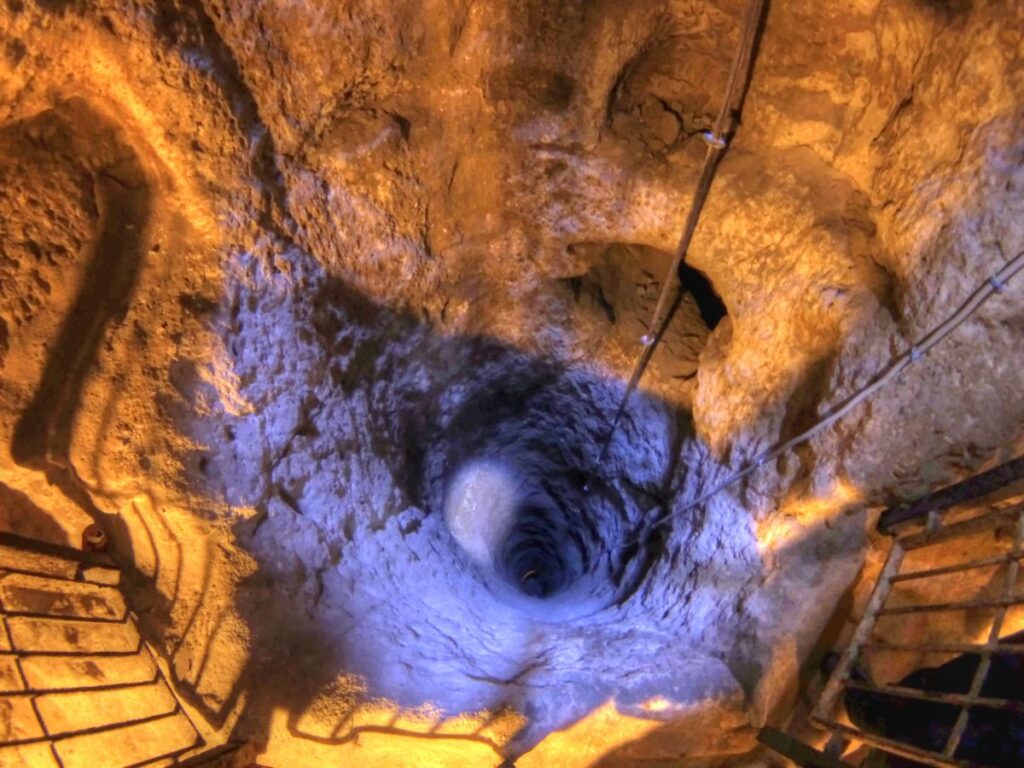
Kaymaklı underground city is 20 kilometers from Nevşehir city. The underground city opened to visitors in 1964, has 8 floors, but only 4 floors can be visited today. The underground cities, which were used most intensely during the Byzantine period, were constantly expanded by the different communities coming to Cappadocia. The traces of the previous archaeological culture were destroyed and took their present form. The reason for the construction of Kaymaklı Underground City is proved by the giant bolts that will lock the doors to prevent any danger from outside. The underground city has 8 floors; however, visitors can visit the first 4 floors today. Underground cities, which have all kinds of possibilities for a society to live temporarily, consist of narrow corridors. There were stables on the first floor of these underground cities. It is on the first floor because the corridors are narrow and, most importantly, it is thought that it will be difficult for the animals to go down. The barn walls are roughly carved, and in the lower parts of the walls, there are cavities where animals can feed and a hole for connecting animals. The barns also provided access to churches and living spaces connected by many corridors. These sliding doors are approximately 1.5-2 meters in diameter and weigh approximately 500 kilograms. The most important feature of the doors, most of which are cut in place, is that they can only be opened from the inside. The reason for this is to create time to defend themselves in the event of an attack. At the same time, it is mentioned that there are secret passages to these underground cities under almost every house in the region and that there are connections with other underground cities. Still, there is no clear information to prove this situation. Other underground city structures, which are warm both in summer and in winter, are wineries and kitchens located on the upper floors for easy transportation of grapes. The grapes collected from the region were brought to the wineries and stored in the wineries after various processes. Considering the number of kitchens, it is revealed that not every family has a kitchen; they use them together. In Cappadocia towns and villages, there are ovens for cooking called “tandır” which are still used today. These types of structures are still used today. Besides, there are small rooms in the kitchens to store supplies. Communication holes are drilled in underground cities for both ventilation and communication. At the same time, these holes are connected to a water well. Some water wells are not connected to the earth so that the enemy does not throw poison here. When you come to the second floor, the church with a single nave and two apses welcomes you here. There are baptismal stones in front of the apse and sitting stones on the sides. It is thought that the side room, which is thought to have been built for church officials, was used as a cemetery. However, there is no clear information to confirm this situation. The most important floors of the underground city are the third and fourth floors. On these floors, there are many food stores and living areas. The most interesting thing on the third floor is the andesite stone used to grind copper ore. This stone is not brought from outside but is one of the andesite lavas under the tuffs revealed during the underground city’s construction. There are 57 crushing and crushing pits as needed.
Tatlarin Underground City (Map)
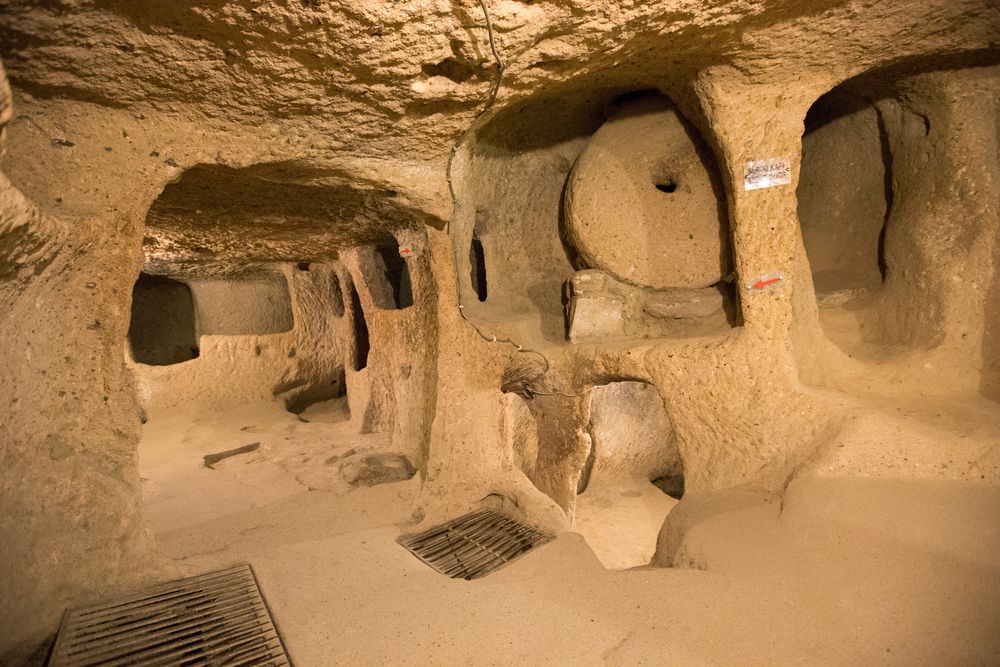
Tatlarin Underground City, which was one of the most important underground cities of the Cappadocia region, could only be discovered in 1975 because its original entrance had collapsed and had gone underground to be opened to the visits of tourists in 1991. The toilet in it demonstrates that toilets were being used in Anatolia around 3000 years ago. There are many food storage areas and churches within it. It is believed to have been used as a center for religious or military purposes judging by the large size of its rooms. Only two floors of the Tatlarin underground city which has spread over a pretty large area can be visited currently, however works continue to open the other floors to visits as well. Although there is a large number of churches around and within the Tatlarin underground city which is near the Acıgöl district of the Nevsehir province a major part of them have collapsed due to natural causes. The Tatlarin underground city is entered through a passageway that is approximately 15 meters long, and the entrance passageway opens to a relatively large hall. There is a sliding stone which has the purpose of sealing off the entrance in the event of an enemy attack. This sliding stone which could only be opened from the inside was used as an instrument of defense against animals and enemies. Three skeletons were found in the section leading downwards from the right side of the hall. The kitchen found on the right side of the hall provokes the idea that this section was used as a burial ground in the Roman period and as a kitchen in the Byzantine period. That is so because the burial places in which the skeletons were found are identical with the burial places used in the Roman period. However, the interior part of the burial places were deeply carved out later so as to put food supplies in them. This large hall at the entrance is connected to a second large area with a zigzagging corridor. There is a trap and a sliding stone against intruders. There is a stable and five food supply storages carved into the floor in this second section which is supported by strong columns. And in the ceiling there is a ventilation well which provides access to the other parts of the city.
Mazi Underground City (Map)

Mazi underground city was discovered by a shepherd and opened to visitors in 1995. The meaning of Mazi is the Ancient City, and there are lots of Early Roman and Byzantine rock tombs in valley where the village was founded. Mazi Village which the ancient name “Mataza” 18 km south from Urgup and 10 km east from kaymakli underground city. There are early Roman period king tombs both perpendicular slope of the valley. Plateau has so many Byzantium period. Mazi underground city has been carved west perpendicular slope of the village into the valley. Detected in 4 different locations input, main entrance hall is built with irregular stones. Big circular stone in the short corridor for control input /output of the underground city. Acroos the entrance space is barn, barns which spread to large areas of the underground city, is indifferent from others. However, there is a carved rock basin middle of a barn is the different speciality from the others. So many barns indicates that welfare level is so high because of the abundance of animal production. Via a short corridor is reached to underground city church from barns. Entrance of this place can be closed with a circular stone. Church abscissa has been carved in the corner and the front is decorated with relief. A space between the barns were used as winery. There is a chimney top of the winery for grapes to fall down.
Ozluce Underground City (Map)
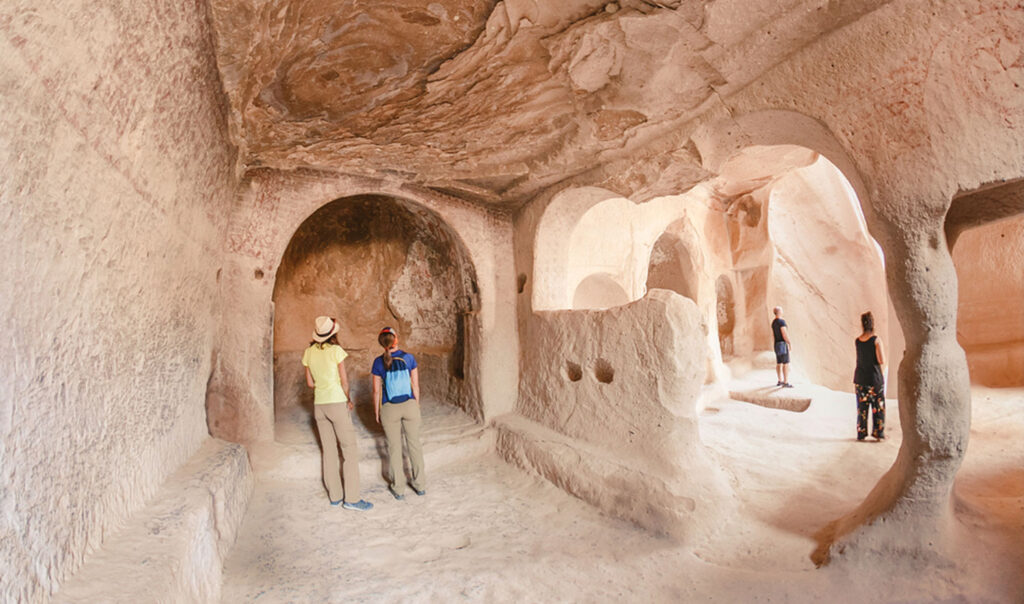
One of the impressive underground cities of Cappadocia is Özlüce Underground City. Özlüce Underground City is located in Özlüce Town of Derinkuyu District of Nevşehir. It is named after the village in which it is located. This underground city is located 6 km west of the Kaymakli Town on the Nevsehir-Derinkuyu motorway. Unlike other underground cities, Özlüce Underground City was built as a single storey on a large area. The entire city is not yet open to visitors. One of the most important features of this city is that the tuff layer it carved contains different colors. When you enter the city, the main space is the largest area of the underground city and consists of two parts. On the right side of the space, there are storage tanks and on the left side, there are living rooms. There are cell-type rooms on the sides.
Cappadocia Fully Guided Package Tours
- Cappadocia Short Break
- Istanbul – Ankara – Cappadocia | 4 Days
- Istanbul – Cappadocia | 6 Days
- Istanbul – Ankara – Cappadocia | 6 Days
- Istanbul – Ankara – Cappadocia | 7 Days
















